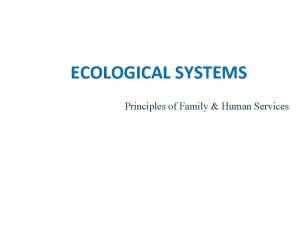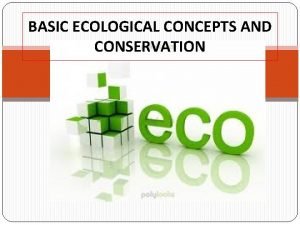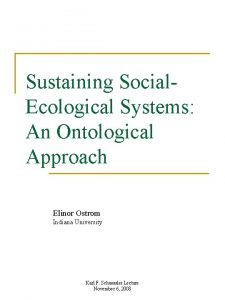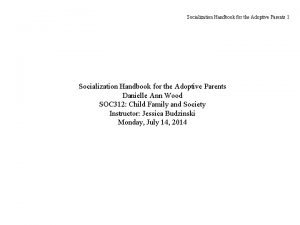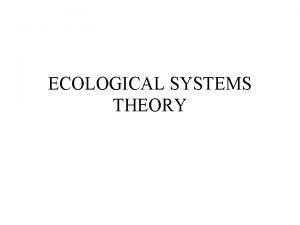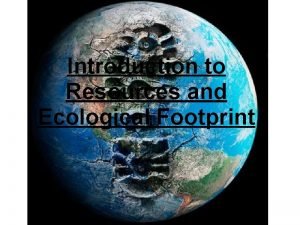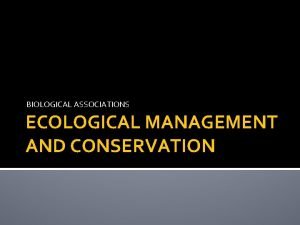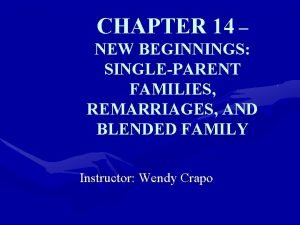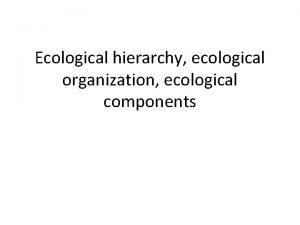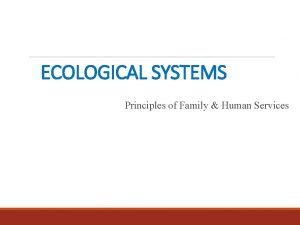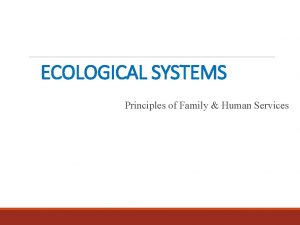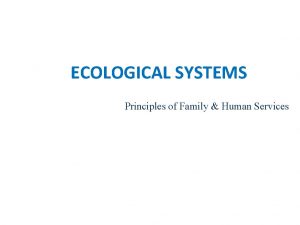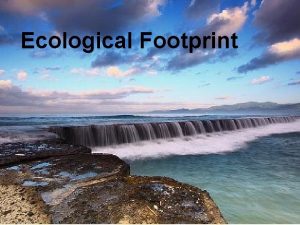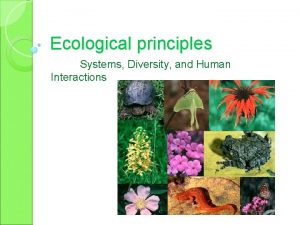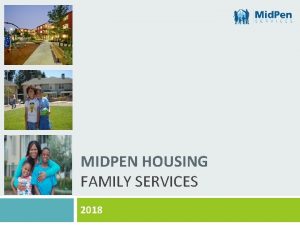ECOLOGICAL SYSTEMS Principles of Family Human Services Lesson
















- Slides: 16

ECOLOGICAL SYSTEMS Principles of Family & Human Services

Lesson Overview 1. What is Bronfenbrenner’s Theory? 2. What factors influence an individual’s development, behaviors and personality? 3. Why is this important to the work of Human Services professionals?

BRONFENBRENNER’S THEORY OF ECOLOGICAL SYSTEMS Brofenbrenner wanted to answer the question, “What influences an individual’s development, behavior, and personality over their lifespan? ” Theory he created is called Ecological Systems Theory

BROFENBRENNER’S THEORY SUGGEST…. q There are LAYERS of influence on an individuals development, behaviors, and personality over their lifespan. q It provides a way of looking at the interactions of humans with their environments as a system. In total he suggested 5 systems that will be explained in following slides q A person’s Biological, social, and physical aspects are considered in context of the individual’s environment q When you think of an individuals Environments think of… 1. Natural world 2. Constructed realities 3. Social/cultural background q Brofenbrenner’s Theory suggests that Changes/conflict ripple through all systems

Think about this… How does war impact individuals?

Brofenbrenner’s Ecological Model This slide shows Brofenbrenner’s Ecological Model as it relates to Child Development. We will go into more detail about each of the systems, but for now notice how the systems radiate outward. Also, notice that the Mesosystem isn’t a distinct “layer, ” but the interactions between two Microsystems.

THE INDIVIDUAL • The individual is defined by their: sex, age, biological, and genetic make up • All other levels or systems directly or indirectly affect the individual at different times in their lifespan.

The 5 Layers impacting an individual’s development 1. 2. 3. 4. 5. Microsystem Mesosystem Exosystem Macrosystem Chronosystem

MICROSYSTEMS q Characterized by interpersonal relationships with close family members, friends, teachers q Have an immediate and direct impact on the individual q Stressors, negative influences or unhealthy relationships can have lasting effects on the individual q Examples: Family, Classroom, Workplace, Religions Settings, Peer Group

MESOSYSTEM q Interrelations between 2 microsystems q What are some examples of interactions at this level? • For example, Family and Classroom, Classroom and Peer Group, Family and Religious Settings, and Religious Settings and Peer Group. • An example of a Family-Classroom inter-relation would be a Parent-Teacher Meeting about a child’s academic performance. What are some examples of inter-relations you can think of for Classroom and Peer Group and Family and Religious Settings?

EXOSYSTEM q Indirectly affects the individual q Examples: School system, medical institutions, mass media, community, government services An example of the exosystem’s influence on an individual would be, a parent’s workplace is causing stress, the child isn’t an active participant in the workplace, but can could be affected when the parent comes home stressed about work

MACROSYSTEM The Macrosystem is the most outer part of the systems. The Macrosystem is essentially the cultural enivronment in which the individual lives and exists. Culture could include such things as political philosophy, economic patterns, social conditions, cultural values, national customs q Evolves slowly and changes over time • Example; a biracial child may identify with the dominant culture while their parent identifies with the minority culture and this creates conflict

CHRONOSYSTEM q Chronological changes in the person or environment over time q How do you think the following changes impacted individuals? q The onset of Alzheimer's disease q De-segregation of schools in the South q Women working outside the home

The Theory in Practice q Person-in-Environment: The person-in-environment perspective in social work is a practice-guiding principle that highlights the importance of understanding an individual and individual behavior in light of the environmental contexts in which that person lives and acts q Evaluating situations and solutions: An understanding of this theory allows us to more accurately assess individuals, families, and communities to determine their needs and anticipate the results of interventions. For example, if we want to do a service project on childhood hunger, we can analyze the situation at the various system levels to design a project that’s likely going to be more effective. It Simplifies the complexity of human systems: Unlike repairing an engine or fixing an air conditioning unit, improving the lives of humans is challenging work. Diagrams and models abound to help a technician understand engines and AC units. This theory tries it’s best to create such a model for human service workers better understand their client-customers.

Let’s Review (Answers on next slide) 1. Which system represents the inter-relations of 2 microsystems? 2. Mass media and community would fall into which system? 3. In which system is the individual directly involved with inter-personal relationships? 4. Which system includes the chronological changes of the individual and culture over time? 5. Which system includes the individual’s cultural environment? 6. What does Person-in-Environment mean?

1. 2. 3. 4. 5. 6. Answers!!! Which system represents the inter-relations of 2 microsystems? Mesosystem Mass media and community would fall into which system? Exosystem In which system is the individual directly involved with inter-personal relationships? Microsystems Which system includes the chronological changes of the individual and culture over time? Chronosystem Which system includes the individual’s cultural environment? Macrosystem What does Person-in-Environment mean? In social work it is a practice-guiding principle that highlights the importance of understanding an individual and individual behavior in light of the environmental contexts in which that person lives and acts.
 Exosystem
Exosystem Objective of family health nursing
Objective of family health nursing Dicapine
Dicapine Wake county human services community services center
Wake county human services community services center Ecological services definition
Ecological services definition Basic ecological concepts
Basic ecological concepts Elinor ostrom social ecological systems
Elinor ostrom social ecological systems Bronfenbrenner's ecological systems theory
Bronfenbrenner's ecological systems theory Bronfenbrenner's ecological systems theory
Bronfenbrenner's ecological systems theory Exosystem
Exosystem Ecological footprint ap human geography definition
Ecological footprint ap human geography definition Urie bronfenbrenner contextual view of development
Urie bronfenbrenner contextual view of development Types of association in ecological management
Types of association in ecological management Difference between nuclear family and joint family
Difference between nuclear family and joint family Carbon family
Carbon family Blended family vs binuclear
Blended family vs binuclear Child, youth and family services act, 2017
Child, youth and family services act, 2017
